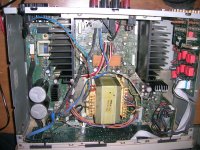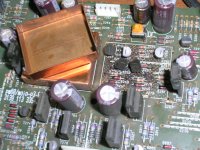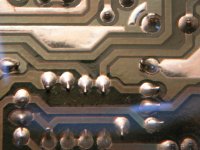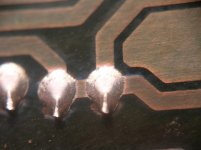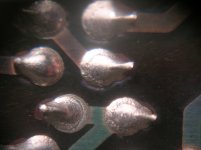yet all amplifiers, pre-amplifiers, phonostages and DAC sound differnt. I think most here are trying to find discriminators when traditional measurements fails.
yet all amplifiers, pre-amplifiers, phonostages and DAC sound differnt. I think most here are trying to find discriminators when traditional measurements fails.
Yes lots of people speculate about discriminators before making sure that there even IS a difference. Such a waste!
jan
What was the amplitude ?.
Dan.
Corner was 50Hz or so and 4nV at flat band. So at 10dB/dec you get around 40mV per root Hz give or take a little. My experiment was to see if I could take a laboratory grade strain gauge based scale and measure the diurnal variation in G. I couldn't at least not directly. The scale was neat I could put a bag of 10000 vector pins on it and remove them 1 at a time and see each one.
Yes lots of people speculate about discriminators before making sure that there even IS a difference. Such a waste!
jan
Never worry about evidence, just keep saying it until it magically becomes true. In American English, this is called "The Tinkerbell Effect."
I just do not understand all the agonizing here over 1/f corners etc when building a decent sounding, low noise preamp is so relatively straight forward. What the hell am I missing here guys?
Pushing the envelope or limits. Which is sometimes like pulling teeth.
Lots of second guessing going on. It isnt that complicated of a request. I would like to run signals into at least 24 bit front end ADC with an absolute minimum of low freq peak-to-peak noise levels. Other apps is with LF test and measurement equipment design. For example, the front end of the ShibaSoku 725D.
Since the rest of the world has moved on, long ago, to digitized systems, the max analog levels in home systems are in the 0.1 to 1v rms levels. But....
I thought here -- with low signal levels (phono) dealt with, someone could recommend all the low noise choices found to work best and sort thru those for my possible use. If not, then that is fine and I'll go look elsewhere.
THx-RNMarsh
Last edited:
Jan Sy, what if we can hear more than we can measure..??
looking at things could also be a way of getting tools to design beyond measurement limitations. or tool to understand certain behavior. the last discussion we had about amplifier-speaker interface showed very clearly that even skilled people have a hard time coming to grasp with that.
So many here never think outside the box, thus limiting designs to do what we have always done. What a shame battering the quest for taking this to another level.
looking at things could also be a way of getting tools to design beyond measurement limitations. or tool to understand certain behavior. the last discussion we had about amplifier-speaker interface showed very clearly that even skilled people have a hard time coming to grasp with that.
So many here never think outside the box, thus limiting designs to do what we have always done. What a shame battering the quest for taking this to another level.
Jan Sy, what if we can hear more than we can measure..??
looking at things could also be a way of getting tools to design beyond measurement limitations. or tool to understand certain behavior. the last discussion we had about amplifier-speaker interface showed very clearly that even skilled people have a hard time coming to grasp with that.
So many here never think outside the box, thus limiting designs to do what we have always done. What a shame battering the quest for taking this to another level.
On here a lot of people think outside the box which is why there are designs being published that are reference grade, but taking different approaches all the time. Generally people do it because they can and because its fun.
As for can we hear the unmeasurable, the scientific evidence is stacked against you. Can you believe you can hear the unmeasurable on sighted tests has however been proven many times. Tests done on placebos is particularly interesting. Give people more sugar pills and they get better faster than those on fewer! (source Ben Goldacre, bad science)
Jan Sy, what if we can hear more than we can measure..??
Ohh that's not a problem at all. There are several dependable methods to find out if there is an audible difference in a specific case. The probem is that nobody seems to bother. That is one reason why after many decades of these kinds of discussion we didn't make any progress.
Like one of my bosses used to say: If you don't know where you're going, any road will take you there 🙂
Just wanted to let you-all know, that i had another great phone call from JC who has been extremely helpful in my quest for a part/device for my goals. And, he understood it right off what I was asking for. I got a very good lead to try out.... got to get samples. Thanks John.
THx-RNMarsh
THx-RNMarsh
Last edited:
Jan Sy, what if we can hear more than we can measure..??
Sound is a physical process involving energy, waves, and a medium. You need to qualify can or can't measure vs just difficult to measure or maybe fully measured there is too much data to process.
So many here never think outside the box,
Richard suggested (for reducing sub Hertz noise) the elimination of air currents circulation around active (and passive) components.
This gives me the opportunity to say that the same air currents upset the DC bias point on some circuits (in a very annoying way if one bothers to monitor them).
The intuitive solution is to encase (confine) these sensitive circuits.
In such a case, the thermal behaviour inside the sub-casing (inside the box 😀) should be monitored on the long run.
I attach photos from an application where they failed to estimate the thermal problems of such a solution. The entrapped heat caused discoloration on the upper side and solder degradation on the lower side of the pcb (with consequent damage to loudspeakers due to intermittent electrical pcb contacts, causing strong power pulses downstream)
George
Attachments
Unfortunately is our passionate hobby getting smaller and smaller, Not much research is going on at universities all focus is on software and digital processing. Whats good for energy efficiency is also good for music seems to be key perception. thus there's not too much commercial Interest to develop new and better way to measure Audio. Basically were left to develop our own methods and draw our own conclusions. Again I'am sad to see that when we talk about speaker/amplifier interface, all the big guys go completely silent. Fact is that nobody really knows what goes on how the amplifier delivers current to speaker, how much that current is bloated by counter current, how nonlinear that current is and Why, How it affects the feedback. Does it develop voltage over the output impedance and is that feed into the feedback.
Why does better numbers not always lead to better sound and why can we hear changes in the power supply even tough it the caps alone holds the rails at 10 Hz full tilt.
Its a bit like measuring Hp on a car with different tires, The Hp may be the same, but the drive... NOT so
We must accept that listening and measuring is NOT the same and we may hear things we have not even considered measuring.
Why does better numbers not always lead to better sound and why can we hear changes in the power supply even tough it the caps alone holds the rails at 10 Hz full tilt.
Its a bit like measuring Hp on a car with different tires, The Hp may be the same, but the drive... NOT so
We must accept that listening and measuring is NOT the same and we may hear things we have not even considered measuring.
why can we hear changes in the power supply even tough it the caps alone holds the rails at 10 Hz full tilt.
My point is that we don't really know if we can hear it or not. We are not checking that just assume we do based on the most unreliable method known to man: perception.
Jan
why can we hear changes in the power supply even tough it the caps alone holds the rails at 10 Hz full tilt.
Because some high end designers are not competent enough to pay attention to PSR. Actual engineering is less important than the narrative.
MiiB, sic transit gloria mundi.
Let's face it, audio has had its heyday and days of glory which ended about 1980 or so, when video took over, and soon after that, was itself taken ovr by the digital era.
I don't think any audio only product made today would make half as big a splash in the world as it could in those days. Consumers today are happy with MP3 no matter what the quality, so long as it's free.
We here still give a damn, but we are a dying breed. The last of the dynosaurs.
Let's face it, audio has had its heyday and days of glory which ended about 1980 or so, when video took over, and soon after that, was itself taken ovr by the digital era.
I don't think any audio only product made today would make half as big a splash in the world as it could in those days. Consumers today are happy with MP3 no matter what the quality, so long as it's free.
We here still give a damn, but we are a dying breed. The last of the dynosaurs.
Yes, it takes trusting your own ears, and those around you, to make progress in audio design. If you don't trust your ears, then nothing much seems to matter.
We here still give a damn, but we are a dying breed. The last of the dynosaurs.
And yet the dinosaurs still live, and fly among us. So will we.
If you don't trust your ears, then nothing much seems to matter.
Other than the marketing. That's where an insistence on peeking helps, right?
- Status
- Not open for further replies.
- Home
- Member Areas
- The Lounge
- John Curl's Blowtorch preamplifier part II
